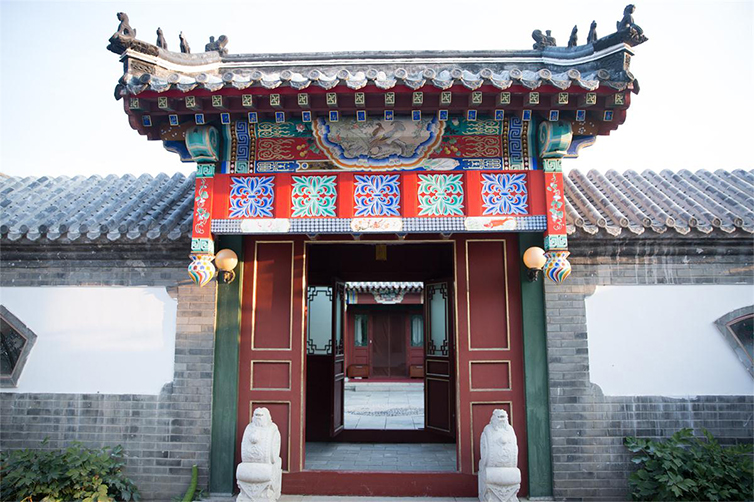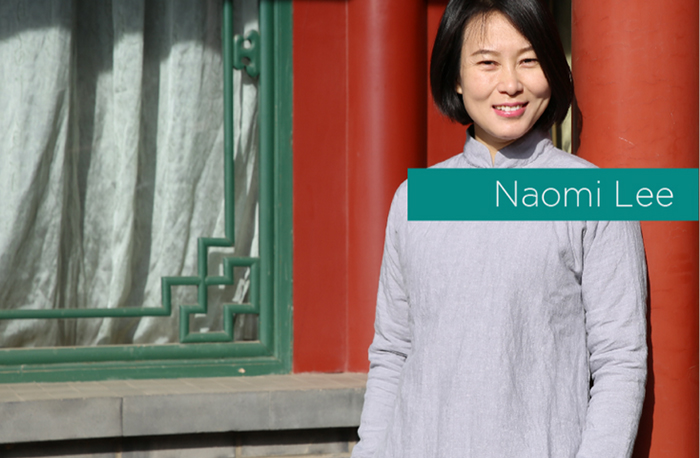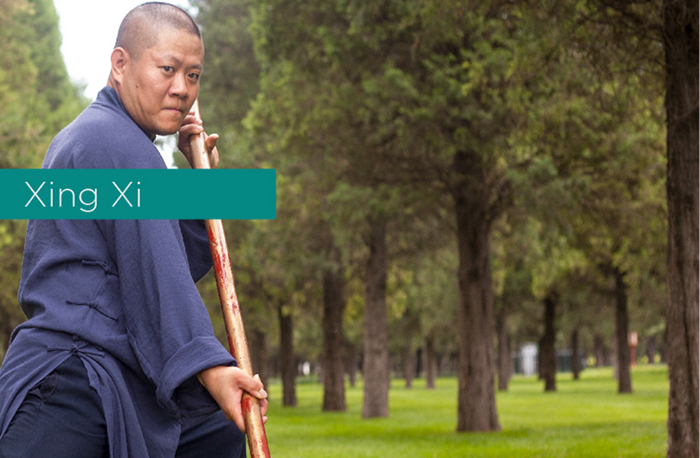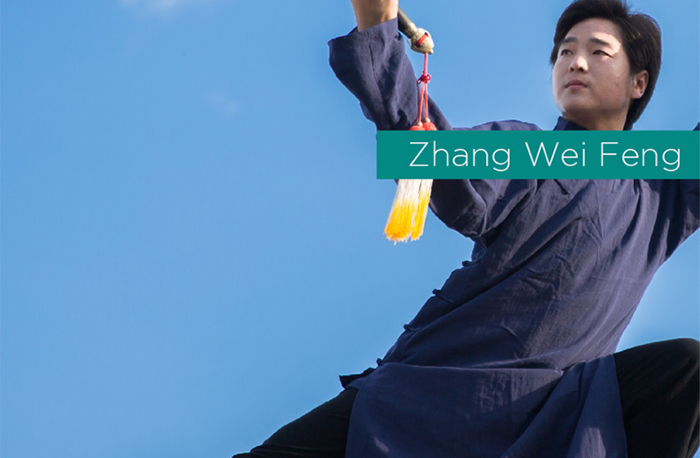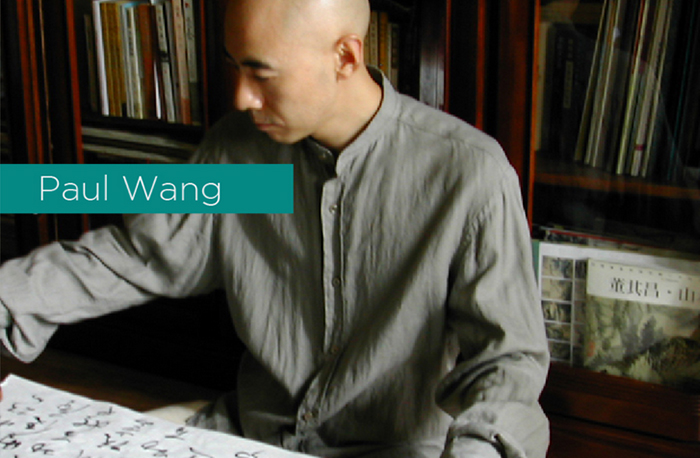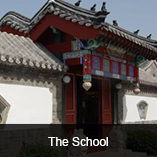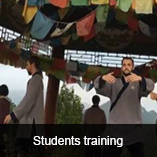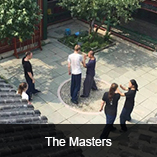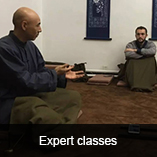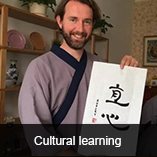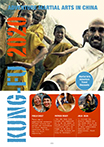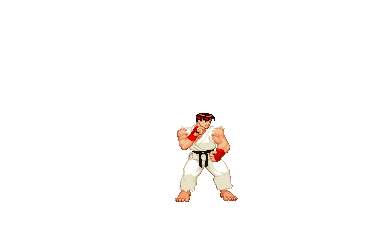Baguàzhang is one of the major "internal" Chinese martial arts. Baguà zhang literally means "eight trigram palm," referring to the trigrams of the I Ching (Yijing), one of the canons of Taoism.
The creation of Baguazhang, as a formalized martial art, is attributed to Dong Haichuan in the early 19th century. He is said to have created it from what he had learned from Taoist, and possibly Buddhist, masters in the mountains of rural China. Evidence suggests Baguazhang is a synthesis of several pre-existing martial arts of rural China combined with Taoist circle walking.
Baguazhang styles include: Yin Style, Shi Style, Cheng Style, Liu Style, Liang Style, Fu Style, Gao Style, Gong Style, Jiang Style and Yin Yang Style. All these styles share the practice of circle walking, or "Turning the Circle". For a beginner traditional training meant walking a circle six to twelve feet in diameter. Practitioners walk around the edge of the circle in various low stances, facing the center, and periodically change direction as they execute forms. Students first learn flexibility and proper body alignment through such exercises, then move on to more complex forms and internal power mechanics. The internal aspects of Baguazhang are similar to, yet distinct from, those of Xingyi and Tai Chi.
Many distinctive styles of weapons are contained within Baguazhang, some use concealment like the "scholar's pen" or a pair of knives (the most elaborate, which are unique to the style, are the crescent-shaped deer horn knives). Baguazhang is also known for practicing with extremely large weapons, such as the B?guàjian or 'Bagua Sword' and B?guàd?o or 'Bagua Broadsword'. Other more conventional weapons are also used like the staff (gun), the spear (qiang), the crutch (guai), the hook sword (gou) and the straight (double-edged) sword. Baguazhang practitioners are also known for being able to use anything as a weapon using the principles of their art.
Baguazhang contains an extremely wide variety of techniques, including various strikes (with palm, fist, elbow, fingers etc), low kicks, joint locking techniques, throws, and distinctively evasive circular footwork. The Baguazhang practitioners are known for their ability to "flow" in and out of the way of objects. This is where the theory of being able to fight multiple attackers came into view.
Strict Baguazhang teaches that if you are to defeat more than one opponent you must first learn to quickly eliminate an opponent with fast and effective joint locks, knockouts, breaks, and other form of physical trauma. Under close examination, Baguazhang can be compared to a form of above ground wrestling. Many of wrestling's philosophies are very similar to Baguazhang's.
Tai chi chuan or Taijiquan is an internal Chinese martial art using hard and soft techniques and represents the fusion of Yin and Yang applied to the human body. Most modern styles of tai chi trace their development to at least one of five traditional schools: Chen Style, Yang Style, Wu/Hao Style, Wu and Sun Style.
Tai chi chuan is generally classified as a soft internal style and its study primarily involves three aspects health, meditation and martial art.
Health: An unhealthy or otherwise uncomfortable person may find it difficult to meditate to a state of calmness or to use tai chi as a martial art. Tai chi's health training therefore concentrates on relieving the physical effects of stress on the body and mind. For those focused on tai chi's martial application, good physical fitness is still an important step towards effective self-defense.
Meditation: The focus and calmness cultivated by the meditative aspect of tai chi is seen as necessary in maintaining optimum health (in the sense of relieving stress and maintaining homeostasis) and in application of the form as a soft style martial art.
Martial art: The ability to use tai chi as a form of self-defense in combat is the test of a student's understanding of the art. Tai chi chuan martially is the study of appropriate changes in response to outside forces; the study of yielding and "sticking" to an incoming attack rather than attempting to meet it with opposing force.
Shaolin Boxing is the short form for 'Shaolin Temple Boxing Techniques'. As a means of spiritual discipline, Shaolin Boxing has been integrated in hundreds of schools, with Chan Buddhist influence or Zen guiding its presence. 'Shaolin boxing styles very greatly. There are in fact hundreds of different boxing styles. Students usually will practice general basics and then will devote him or herself to one or two boxing and weapon styles.
Shaolin Kung fu practice is generally talked about in terms of three realms.
1. In the primary realm, the practitioner practices their form and appearance.
2. In the intermediate realm, there is the integration of mind and fist, changing the tangible into the intangible, turning the law into the lawless; obeying no rules, having no movement to follow, controlling the enemy in the intangible. An ancient boxing manual reads, `defeat a person in the intangible or fail being seen`.
3. Shaolin Kungfu's highest realm is for all to be guided by the heart and to fight not just from form but from the formless.
Shaolin Buddhist practice is started in the mindful training of Kung Fu as it cultivates greater awareness. The purpose of learning Kung Fu no longer becomes the goal in itself, but is used as a means of awakening.
Features of Shaolin Kung Fu
1. Short but precise.
2. Box in a line.
3. Casual footwork.
4. Roll in and out.
5. Integration of mind and behavior.
6. Bending but actually not and straight but actually not.
7. Rise high in a tight form and drop in a spreading way. Rise to move with an intention of advance and drop to move with an intention of retreat.
8. Integration of Buddhism and boxing.
9. Focus on defense.
10. Combination of attacking and defending.
11. Numerous tricks.
12. Simple and practical.
13. Vigorous and strong.
14. Numerous acts shrinking back.
15. Numerous kicks.
16. Produce sounds.
Qigong, qi gong, chi kung, or chi gung (simplified Chinese: 气功; traditional Chinese: 氣功; pinyin: qìgōng; Wade–Giles: chi gong; literally: "Life Energy Cultivation") is a holistic system of coordinated body posture and movement, breathing, and meditation used for health, spirituality, and martial arts training. With roots in Chinese medicine, philosophy, and martial arts, qigong is traditionally viewed as a practice to cultivate and balance qi (chi) or what has been translated as "life energy".[1]
According to Daoist, Buddhist, and Confucian philosophy, respectively, qigong allows access to higher realms of awareness, awakens one's "true nature", and helps develop human potential.[2]
Qigong practice typically involves moving meditation, coordinating slow flowing movement, deep rhythmic breathing, and calm meditative state of mind. Qigong is now practiced throughout China and worldwide for recreation, exercise and relaxation, preventive medicine and self-healing, alternative medicine, meditation and self-cultivation, and training for martial arts.
Qigong, qi gong, chi kung, or chi gung (simplified Chinese: 气功; traditional Chinese: 氣功; pinyin: qìgōng; Wade–Giles: chi gong; literally: "Life Energy Cultivation") is a holistic system of coordinated body posture and movement, breathing, and meditation used for health, spirituality, and martial arts training. With roots in Chinese medicine, philosophy, and martial arts, qigong is traditionally viewed as a practice to cultivate and balance qi (chi) or what has been translated as "life energy".[1]
According to Daoist, Buddhist, and Confucian philosophy, respectively, qigong allows access to higher realms of awareness, awakens one's "true nature", and helps develop human potential.[2]
Qigong practice typically involves moving meditation, coordinating slow flowing movement, deep rhythmic breathing, and calm meditative state of mind. Qigong is now practiced throughout China and worldwide for recreation, exercise and relaxation, preventive medicine and self-healing, alternative medicine, meditation and self-cultivation, and training for martial arts.
https://en.wikipedia.org/wiki/Qigong
